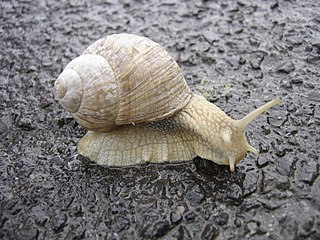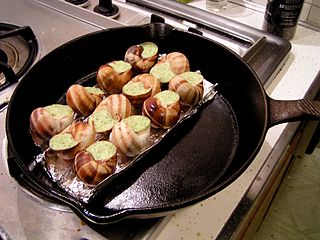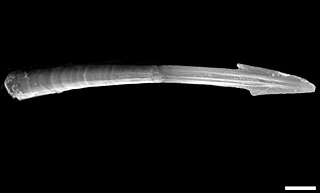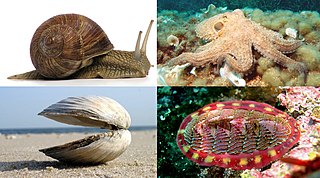
A snail is, in loose terms, a shelled gastropod. The name is most often applied to land snails, terrestrial pulmonate gastropod molluscs. However, the common name snail is also used for most of the members of the molluscan class Gastropoda that have a coiled shell that is large enough for the animal to retract completely into. When the word "snail" is used in this most general sense, it includes not just land snails but also numerous species of sea snails and freshwater snails. Gastropods that naturally lack a shell, or have only an internal shell, are mostly called slugs, and land snails that have only a very small shell are often called semi-slugs.

The gastropods, commonly known as snails and slugs, belong to a large taxonomic class of invertebrates within the phylum Mollusca called Gastropoda.

Conidae, with the current common name of "cone snails", is a taxonomic family of predatory sea snails, marine gastropod molluscs in the superfamily Conoidea.

Ampullariidae, common name the apple snails, is a family of large freshwater snails, aquatic gastropod mollusks with a gill and an operculum. This family is in the superfamily Ampullarioidea and is the type family of that superfamily.

Escargot, from the French word for snail, is a dish consisting of cooked land snails. It is often served as an hors d'oeuvre and is common in France and parts of India. Escargot is part of the typical cuisines of Cyprus, Malta, Crete, areas of mainland Greece, as well as the North African countries Tunisia, Algeria, and Morocco. Escargot is consumed in Germany, Great Britain, Italy, Portugal, and Spain.

Neogastropoda is a clade of sea snails, both freshwater and marine gastropod molluscs.

Heterobranchia, the heterobranchs, is a taxonomic clade of snails and slugs, which includes marine, aquatic and terrestrial gastropod mollusks.

Biomphalaria is a genus of air-breathing freshwater snails, aquatic pulmonate gastropod mollusks in the family Planorbidae, the ram's horn snails and their allies.

Pterostylis is a genus of about 300 species of plants in the orchid family, Orchidaceae. Commonly called greenhood orchids, they are terrestrial, deciduous, perennial, tuberous, herbs found in Australia, New Zealand, New Guinea, New Caledonia and one Indonesian island. The flowers are mostly green, sometimes with brown, reddish or white stripes, and are distinguished from other orchids by their unusual flower structures and pollination mechanism.

Cornu aspersum, known by the common name garden snail, is a species of land snail in the family Helicidae, which includes some of the most familiar land snails. Of all terrestrial molluscs, this species may well be the most widely known. It was classified under the name Helix aspersa for over two centuries, but the prevailing classification now places it in the genus Cornu.

Helix pomatia, common names the Roman snail, Burgundy snail, edible snail, or escargot, is a species of large, edible, air-breathing land snail, a pulmonate gastropod terrestrial mollusc in the family Helicidae. It is one of Europe's biggest species of land snail.

The New Zealand mud snail is a species of very small freshwater snail with a gill and an operculum. This aquatic gastropod mollusk is in the family Tateidae.

Lissachatina fulica is a species of large land snail that belongs in the subfamily Achatininae of the family Achatinidae.

The red-rimmed melania, scientific name Melanoides tuberculata, is a species of freshwater snail with an operculum, a parthenogenetic, aquatic gastropod mollusk in the family Thiaridae.

Conoidea is a superfamily of predatory sea snails, marine gastropod mollusks within the suborder Hypsogastropoda. This superfamily is a very large group of marine mollusks, estimated at about 340 recent valid genera and subgenera, and considered by one authority to contain 4,000 named living species.

Cone snails, cone shells, or cones are a large group of small- to large-sized extremely venomous predatory sea snails, marine gastropod molluscs.

A land snail is any of the numerous species of snail that live on land, as opposed to the sea snails and freshwater snails. Land snail is the common name for terrestrial gastropod mollusks that have shells. However, it is not always easy to say which species are terrestrial, because some are more or less amphibious between land and fresh water, and others are relatively amphibious between land and salt water.

A love dart is a sharp, calcareous or chitinous dart which some hermaphroditic land snails and slugs create. Love darts are both formed and stored internally in a dart sac. These darts are made in sexually mature animals only, and are used as part of the sequence of events during courtship, before actual mating takes place. Darts are quite large compared to the size of the animal: in the case of the semi-slug genus Parmarion, the length of a dart can be up to one fifth that of the semi-slug's foot.

Mollusca is the second-largest phylum of invertebrate animals after the Arthropoda. The members are known as molluscs or mollusks. Around 85,000 extant species of molluscs are recognized. The number of fossil species is estimated between 60,000 and 100,000 additional species. The proportion of undescribed species is very high. Many taxa remain poorly studied.

Freshwater snails are gastropod mollusks which live in fresh water. There are many different families. They are found throughout the world in various habitats, ranging from ephemeral pools to the largest lakes, and from small seeps and springs to major rivers. The great majority of freshwater gastropods have a shell, with very few exceptions. Some groups of snails that live in freshwater respire using gills, whereas other groups need to reach the surface to breathe air. In addition, some are amphibious and have both gills and a lung. Most feed on algae, but many are detritivores and some are filter feeders.



















